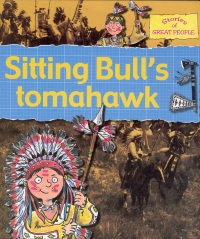| ________________
CM . . .
. Volume XV Number 10. . . .January 9, 2009
excerpt:
Part of the "Stories of Great People" series, Sitting Bull's Tomahawk is the biography of the famous Sioux chief, Sitting Bull, who was the last Sioux to surrender to the American government. This book is also an examination of the period of American history when fur traders, settlers, gold prospectors and cowboys expanded westward, increasing the territory of the United States. During this expansion, the Native nations were nearly wiped out, and their traditional way of life disappeared. As in other books in this series, the narration begins with Digby's discovery of an artifact, a tomahawk in this case, Sitting Bull's ceremonial tomahawk. Mr. Rummage, a market vendor, with interjections from Colonel Karbuncle, who sells military artifacts, provides the children, Digby and Hannah, with a biographical account of this historical character. Mr. Rummage's conversational narration recounts the life of Sitting Bull from a young brave to a warrior chief uniting the Sioux people and battling the American soldiers in order to protect their land and preserve their way of life. The narration is complemented by factual information on the people and events of the time such as George A. Custer, reservations, the gold rush, the railway, Buffalo Bill's Wild West show and more. The dialogue provides the reader with an engaging account of a brave Native American chief who, in spite of his efforts, witnessed the dissolution of the Native way of life and the loss of his people's territory during the latter part of the nineteenth century. Highly Recommended. Janice Foster, a recently retired teacher-librarian, lives in Winnipeg, MB.
To comment
on this title or this review, send mail to cm@umanitoba.ca.
Copyright © the Manitoba Library Association. Reproduction for personal
use is permitted only if this copyright notice is maintained. Any
other reproduction is prohibited without permission.
NEXT REVIEW |
TABLE OF CONTENTS FOR THIS ISSUE
- January 9, 2009.
AUTHORS |
TITLES |
MEDIA REVIEWS |
PROFILES |
BACK ISSUES |
SEARCH |
CMARCHIVE |
HOME |
